Developing an International Marketing Strategy for Hank's Foods
VerifiedAdded on 2023/06/12
|28
|7369
|162
Report
AI Summary
This report outlines an international marketing strategy for Hank's Foods as it ventures into the Japanese market. It begins by defining the company's objectives, which include increasing profitability and promoting health and wellness through low-calorie, low-sugar products. The report then analyzes the Japanese market environment using a PEST analysis, assessing political stability, economic growth, social factors, and technological advancements. A competitor analysis, utilizing Porter's Generic Strategies, evaluates Hank's Foods' potential competitive advantages against existing players like Aohata Corporation. Market readiness is assessed via a SWOT analysis, identifying strengths, weaknesses, opportunities, and threats. The report concludes by recommending a mode of entry and detailing an STPD (Segmentation, Targeting, Positioning, and Differentiation) strategy, along with specific product, price, promotion, and distribution strategies tailored for the Japanese market.
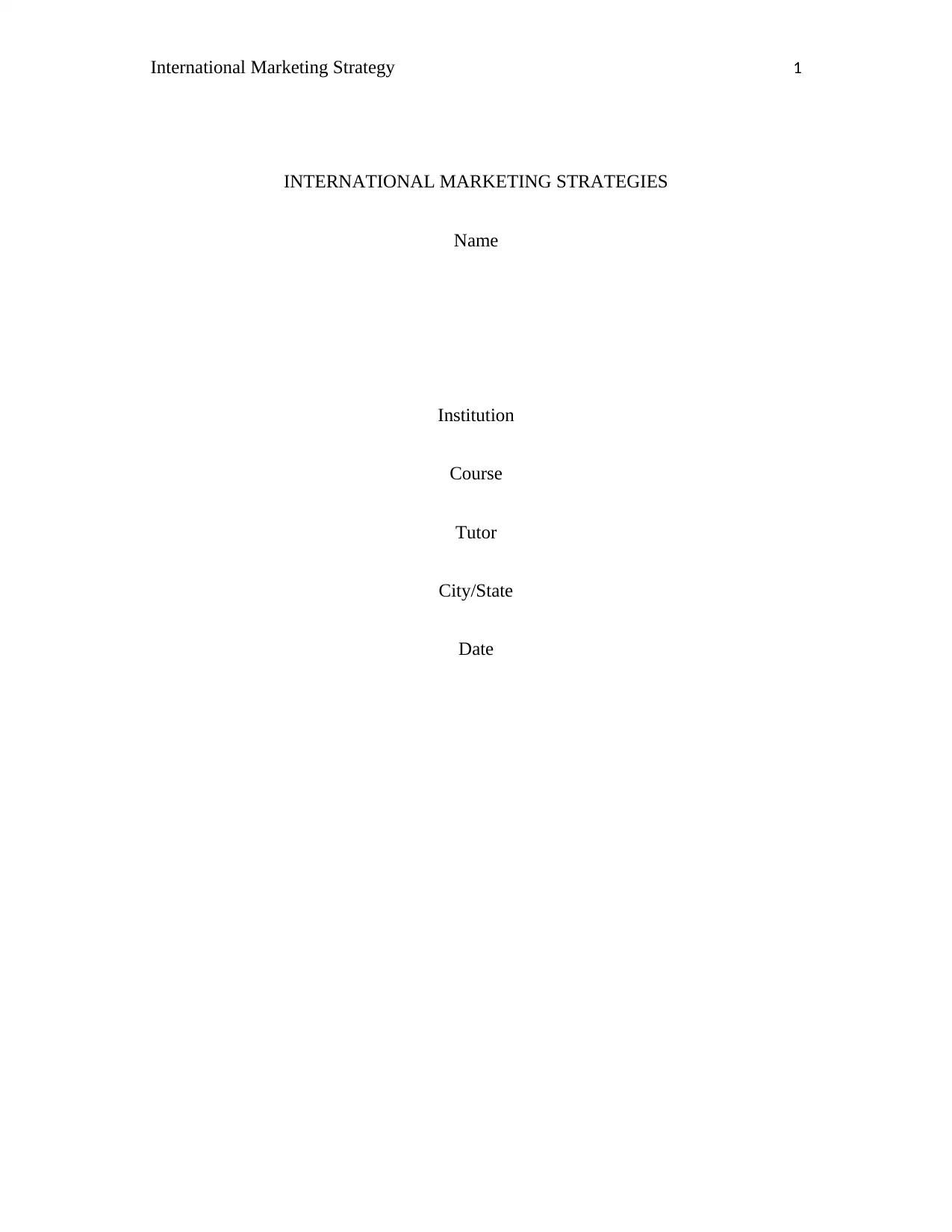
International Marketing Strategy 1
INTERNATIONAL MARKETING STRATEGIES
Name
Institution
Course
Tutor
City/State
Date
INTERNATIONAL MARKETING STRATEGIES
Name
Institution
Course
Tutor
City/State
Date
Paraphrase This Document
Need a fresh take? Get an instant paraphrase of this document with our AI Paraphraser
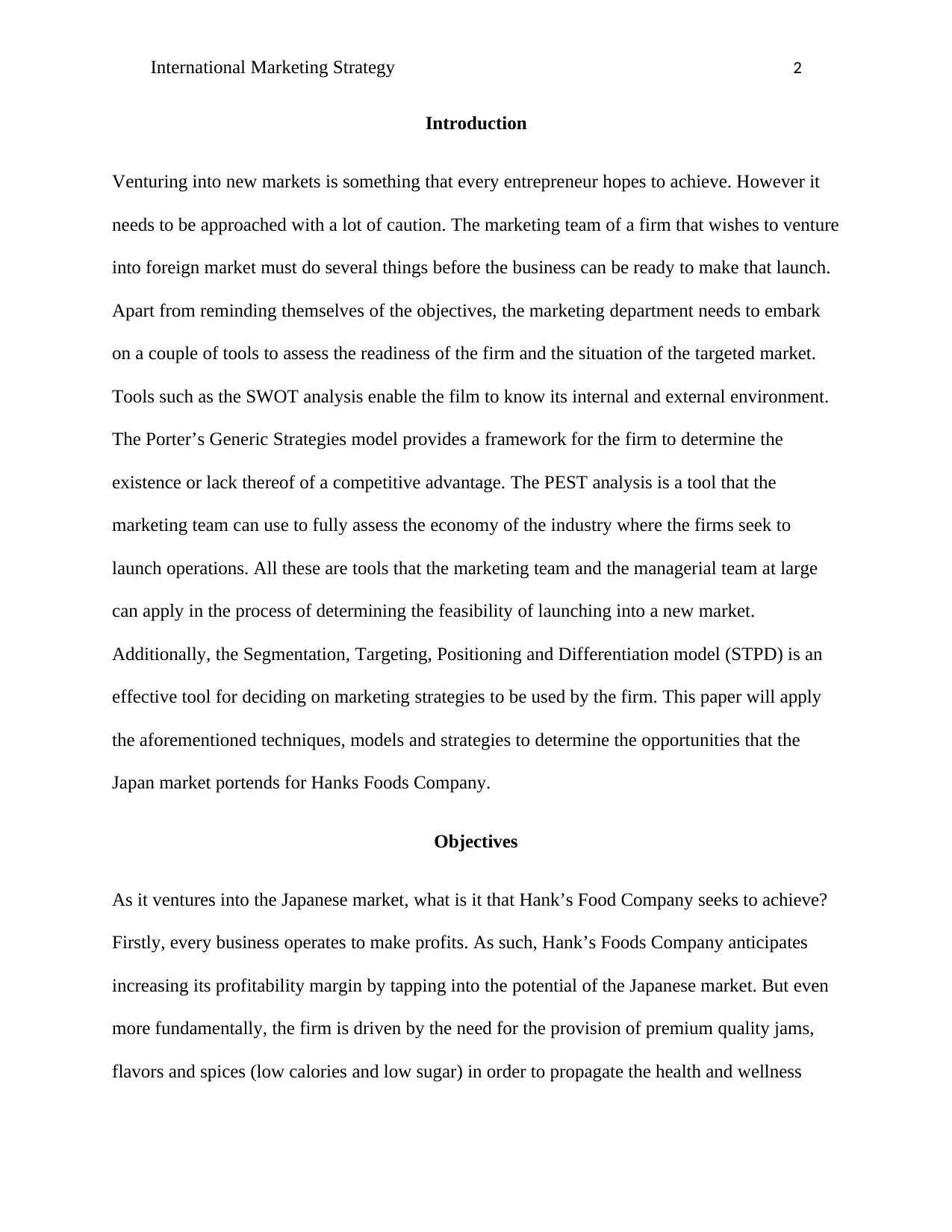
International Marketing Strategy 2
Introduction
Venturing into new markets is something that every entrepreneur hopes to achieve. However it
needs to be approached with a lot of caution. The marketing team of a firm that wishes to venture
into foreign market must do several things before the business can be ready to make that launch.
Apart from reminding themselves of the objectives, the marketing department needs to embark
on a couple of tools to assess the readiness of the firm and the situation of the targeted market.
Tools such as the SWOT analysis enable the film to know its internal and external environment.
The Porter’s Generic Strategies model provides a framework for the firm to determine the
existence or lack thereof of a competitive advantage. The PEST analysis is a tool that the
marketing team can use to fully assess the economy of the industry where the firms seek to
launch operations. All these are tools that the marketing team and the managerial team at large
can apply in the process of determining the feasibility of launching into a new market.
Additionally, the Segmentation, Targeting, Positioning and Differentiation model (STPD) is an
effective tool for deciding on marketing strategies to be used by the firm. This paper will apply
the aforementioned techniques, models and strategies to determine the opportunities that the
Japan market portends for Hanks Foods Company.
Objectives
As it ventures into the Japanese market, what is it that Hank’s Food Company seeks to achieve?
Firstly, every business operates to make profits. As such, Hank’s Foods Company anticipates
increasing its profitability margin by tapping into the potential of the Japanese market. But even
more fundamentally, the firm is driven by the need for the provision of premium quality jams,
flavors and spices (low calories and low sugar) in order to propagate the health and wellness
Introduction
Venturing into new markets is something that every entrepreneur hopes to achieve. However it
needs to be approached with a lot of caution. The marketing team of a firm that wishes to venture
into foreign market must do several things before the business can be ready to make that launch.
Apart from reminding themselves of the objectives, the marketing department needs to embark
on a couple of tools to assess the readiness of the firm and the situation of the targeted market.
Tools such as the SWOT analysis enable the film to know its internal and external environment.
The Porter’s Generic Strategies model provides a framework for the firm to determine the
existence or lack thereof of a competitive advantage. The PEST analysis is a tool that the
marketing team can use to fully assess the economy of the industry where the firms seek to
launch operations. All these are tools that the marketing team and the managerial team at large
can apply in the process of determining the feasibility of launching into a new market.
Additionally, the Segmentation, Targeting, Positioning and Differentiation model (STPD) is an
effective tool for deciding on marketing strategies to be used by the firm. This paper will apply
the aforementioned techniques, models and strategies to determine the opportunities that the
Japan market portends for Hanks Foods Company.
Objectives
As it ventures into the Japanese market, what is it that Hank’s Food Company seeks to achieve?
Firstly, every business operates to make profits. As such, Hank’s Foods Company anticipates
increasing its profitability margin by tapping into the potential of the Japanese market. But even
more fundamentally, the firm is driven by the need for the provision of premium quality jams,
flavors and spices (low calories and low sugar) in order to propagate the health and wellness
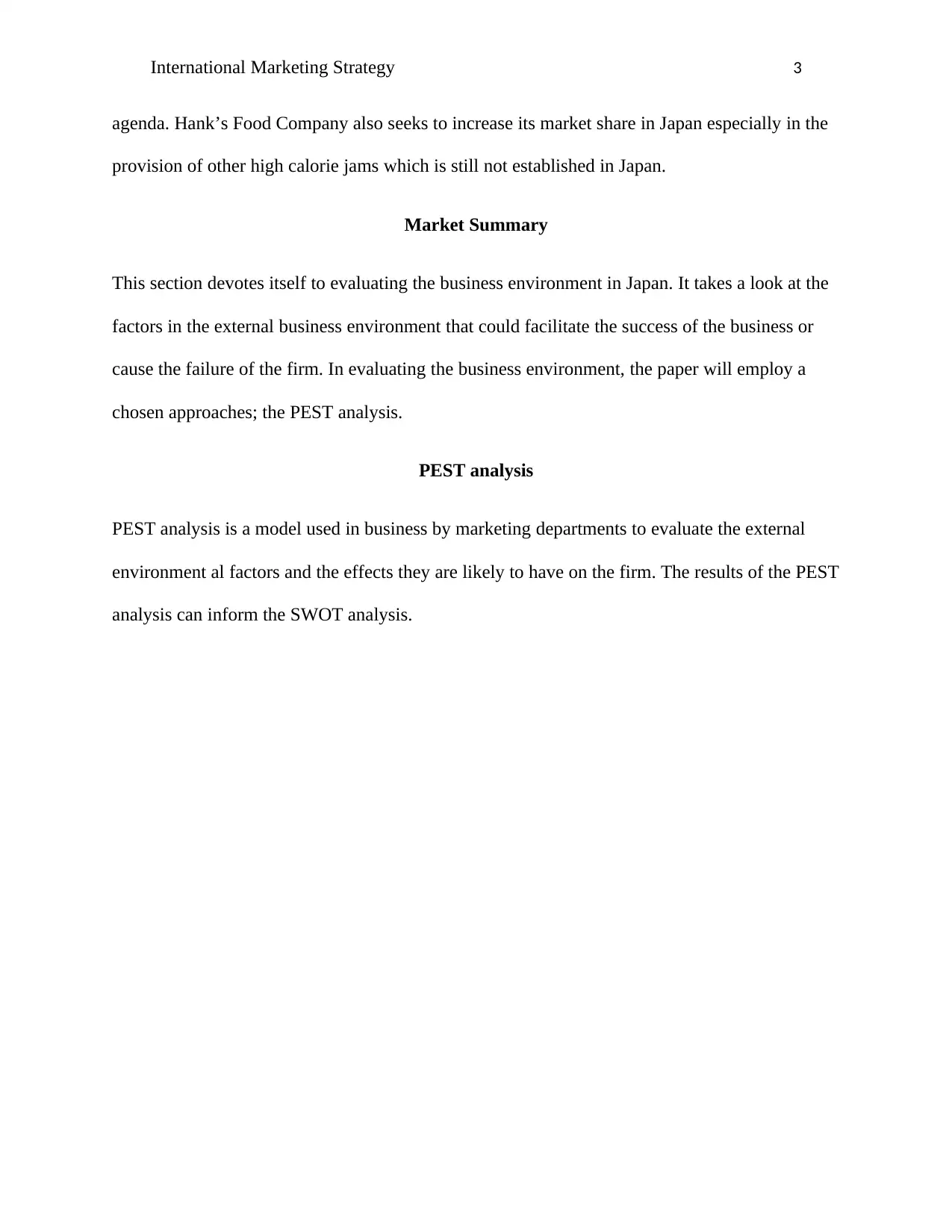
International Marketing Strategy 3
agenda. Hank’s Food Company also seeks to increase its market share in Japan especially in the
provision of other high calorie jams which is still not established in Japan.
Market Summary
This section devotes itself to evaluating the business environment in Japan. It takes a look at the
factors in the external business environment that could facilitate the success of the business or
cause the failure of the firm. In evaluating the business environment, the paper will employ a
chosen approaches; the PEST analysis.
PEST analysis
PEST analysis is a model used in business by marketing departments to evaluate the external
environment al factors and the effects they are likely to have on the firm. The results of the PEST
analysis can inform the SWOT analysis.
agenda. Hank’s Food Company also seeks to increase its market share in Japan especially in the
provision of other high calorie jams which is still not established in Japan.
Market Summary
This section devotes itself to evaluating the business environment in Japan. It takes a look at the
factors in the external business environment that could facilitate the success of the business or
cause the failure of the firm. In evaluating the business environment, the paper will employ a
chosen approaches; the PEST analysis.
PEST analysis
PEST analysis is a model used in business by marketing departments to evaluate the external
environment al factors and the effects they are likely to have on the firm. The results of the PEST
analysis can inform the SWOT analysis.
⊘ This is a preview!⊘
Do you want full access?
Subscribe today to unlock all pages.

Trusted by 1+ million students worldwide
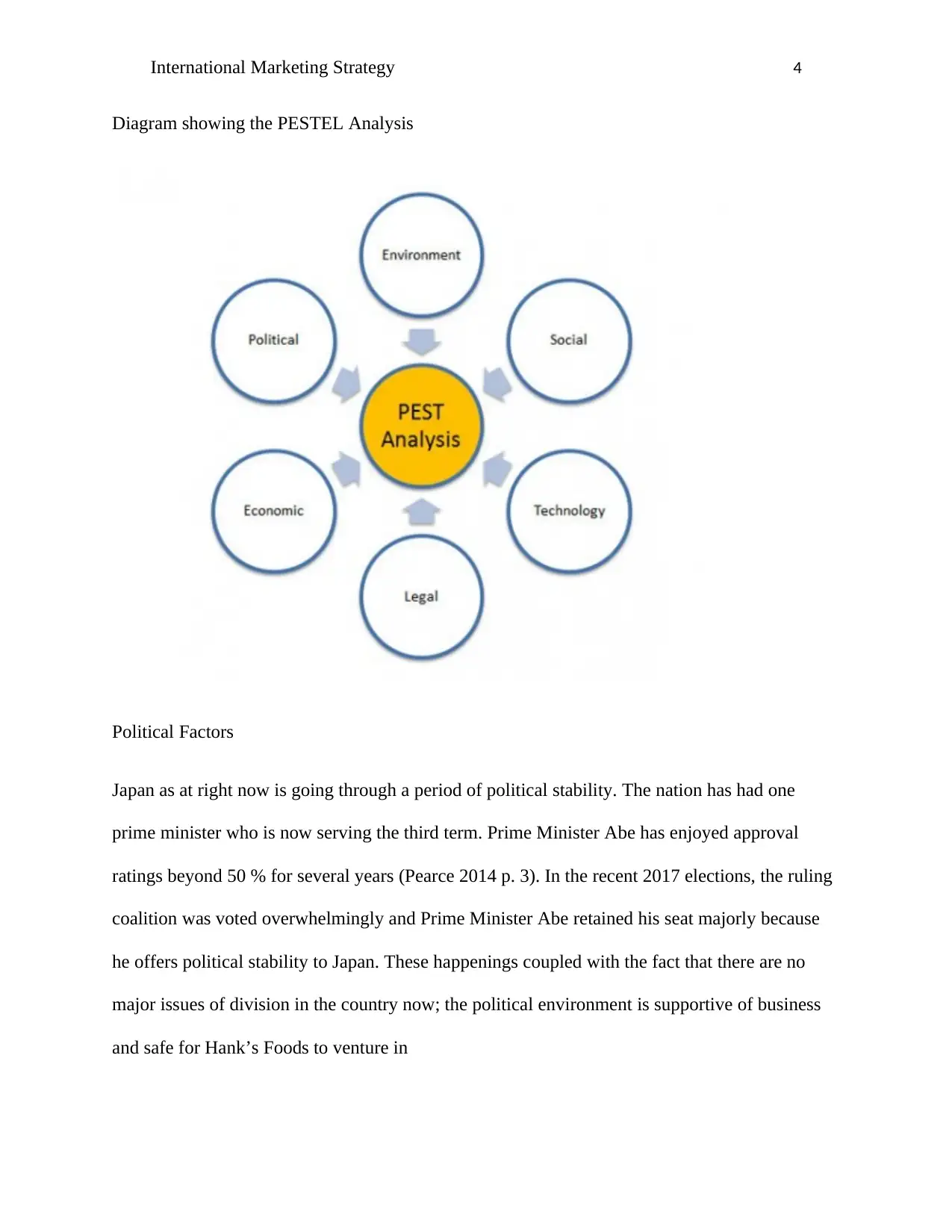
International Marketing Strategy 4
Diagram showing the PESTEL Analysis
Political Factors
Japan as at right now is going through a period of political stability. The nation has had one
prime minister who is now serving the third term. Prime Minister Abe has enjoyed approval
ratings beyond 50 % for several years (Pearce 2014 p. 3). In the recent 2017 elections, the ruling
coalition was voted overwhelmingly and Prime Minister Abe retained his seat majorly because
he offers political stability to Japan. These happenings coupled with the fact that there are no
major issues of division in the country now; the political environment is supportive of business
and safe for Hank’s Foods to venture in
Diagram showing the PESTEL Analysis
Political Factors
Japan as at right now is going through a period of political stability. The nation has had one
prime minister who is now serving the third term. Prime Minister Abe has enjoyed approval
ratings beyond 50 % for several years (Pearce 2014 p. 3). In the recent 2017 elections, the ruling
coalition was voted overwhelmingly and Prime Minister Abe retained his seat majorly because
he offers political stability to Japan. These happenings coupled with the fact that there are no
major issues of division in the country now; the political environment is supportive of business
and safe for Hank’s Foods to venture in
Paraphrase This Document
Need a fresh take? Get an instant paraphrase of this document with our AI Paraphraser
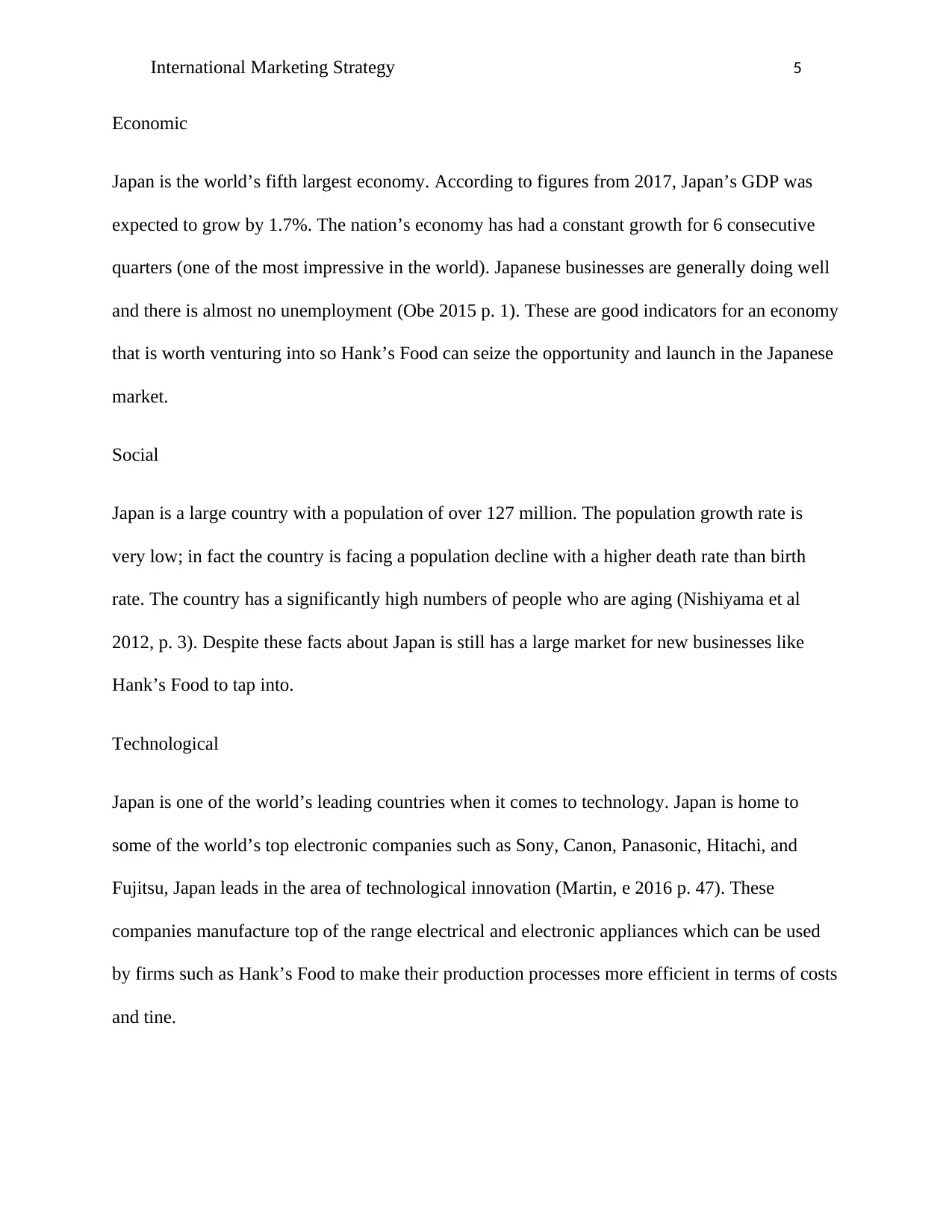
International Marketing Strategy 5
Economic
Japan is the world’s fifth largest economy. According to figures from 2017, Japan’s GDP was
expected to grow by 1.7%. The nation’s economy has had a constant growth for 6 consecutive
quarters (one of the most impressive in the world). Japanese businesses are generally doing well
and there is almost no unemployment (Obe 2015 p. 1). These are good indicators for an economy
that is worth venturing into so Hank’s Food can seize the opportunity and launch in the Japanese
market.
Social
Japan is a large country with a population of over 127 million. The population growth rate is
very low; in fact the country is facing a population decline with a higher death rate than birth
rate. The country has a significantly high numbers of people who are aging (Nishiyama et al
2012, p. 3). Despite these facts about Japan is still has a large market for new businesses like
Hank’s Food to tap into.
Technological
Japan is one of the world’s leading countries when it comes to technology. Japan is home to
some of the world’s top electronic companies such as Sony, Canon, Panasonic, Hitachi, and
Fujitsu, Japan leads in the area of technological innovation (Martin, e 2016 p. 47). These
companies manufacture top of the range electrical and electronic appliances which can be used
by firms such as Hank’s Food to make their production processes more efficient in terms of costs
and tine.
Economic
Japan is the world’s fifth largest economy. According to figures from 2017, Japan’s GDP was
expected to grow by 1.7%. The nation’s economy has had a constant growth for 6 consecutive
quarters (one of the most impressive in the world). Japanese businesses are generally doing well
and there is almost no unemployment (Obe 2015 p. 1). These are good indicators for an economy
that is worth venturing into so Hank’s Food can seize the opportunity and launch in the Japanese
market.
Social
Japan is a large country with a population of over 127 million. The population growth rate is
very low; in fact the country is facing a population decline with a higher death rate than birth
rate. The country has a significantly high numbers of people who are aging (Nishiyama et al
2012, p. 3). Despite these facts about Japan is still has a large market for new businesses like
Hank’s Food to tap into.
Technological
Japan is one of the world’s leading countries when it comes to technology. Japan is home to
some of the world’s top electronic companies such as Sony, Canon, Panasonic, Hitachi, and
Fujitsu, Japan leads in the area of technological innovation (Martin, e 2016 p. 47). These
companies manufacture top of the range electrical and electronic appliances which can be used
by firms such as Hank’s Food to make their production processes more efficient in terms of costs
and tine.
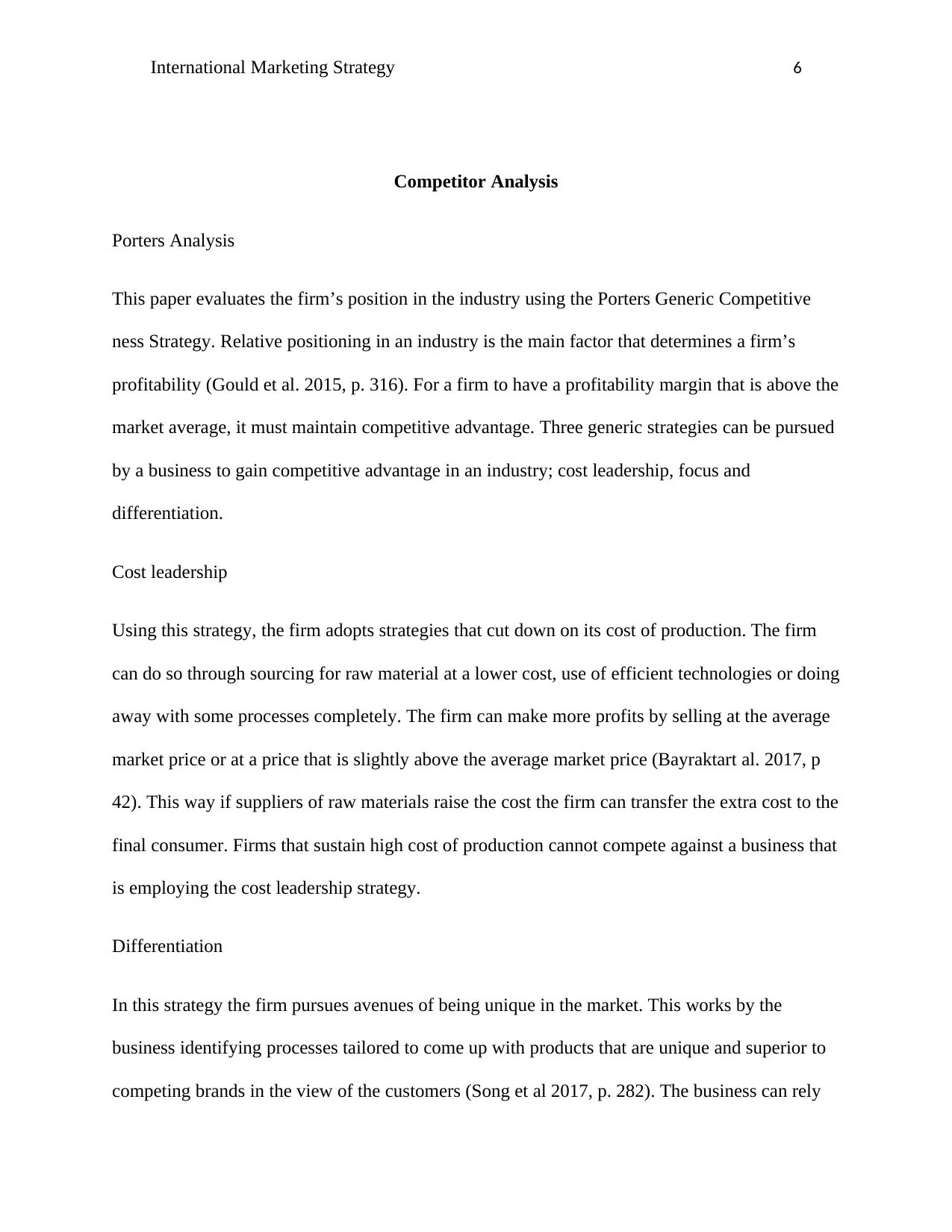
International Marketing Strategy 6
Competitor Analysis
Porters Analysis
This paper evaluates the firm’s position in the industry using the Porters Generic Competitive
ness Strategy. Relative positioning in an industry is the main factor that determines a firm’s
profitability (Gould et al. 2015, p. 316). For a firm to have a profitability margin that is above the
market average, it must maintain competitive advantage. Three generic strategies can be pursued
by a business to gain competitive advantage in an industry; cost leadership, focus and
differentiation.
Cost leadership
Using this strategy, the firm adopts strategies that cut down on its cost of production. The firm
can do so through sourcing for raw material at a lower cost, use of efficient technologies or doing
away with some processes completely. The firm can make more profits by selling at the average
market price or at a price that is slightly above the average market price (Bayraktart al. 2017, p
42). This way if suppliers of raw materials raise the cost the firm can transfer the extra cost to the
final consumer. Firms that sustain high cost of production cannot compete against a business that
is employing the cost leadership strategy.
Differentiation
In this strategy the firm pursues avenues of being unique in the market. This works by the
business identifying processes tailored to come up with products that are unique and superior to
competing brands in the view of the customers (Song et al 2017, p. 282). The business can rely
Competitor Analysis
Porters Analysis
This paper evaluates the firm’s position in the industry using the Porters Generic Competitive
ness Strategy. Relative positioning in an industry is the main factor that determines a firm’s
profitability (Gould et al. 2015, p. 316). For a firm to have a profitability margin that is above the
market average, it must maintain competitive advantage. Three generic strategies can be pursued
by a business to gain competitive advantage in an industry; cost leadership, focus and
differentiation.
Cost leadership
Using this strategy, the firm adopts strategies that cut down on its cost of production. The firm
can do so through sourcing for raw material at a lower cost, use of efficient technologies or doing
away with some processes completely. The firm can make more profits by selling at the average
market price or at a price that is slightly above the average market price (Bayraktart al. 2017, p
42). This way if suppliers of raw materials raise the cost the firm can transfer the extra cost to the
final consumer. Firms that sustain high cost of production cannot compete against a business that
is employing the cost leadership strategy.
Differentiation
In this strategy the firm pursues avenues of being unique in the market. This works by the
business identifying processes tailored to come up with products that are unique and superior to
competing brands in the view of the customers (Song et al 2017, p. 282). The business can rely
⊘ This is a preview!⊘
Do you want full access?
Subscribe today to unlock all pages.

Trusted by 1+ million students worldwide
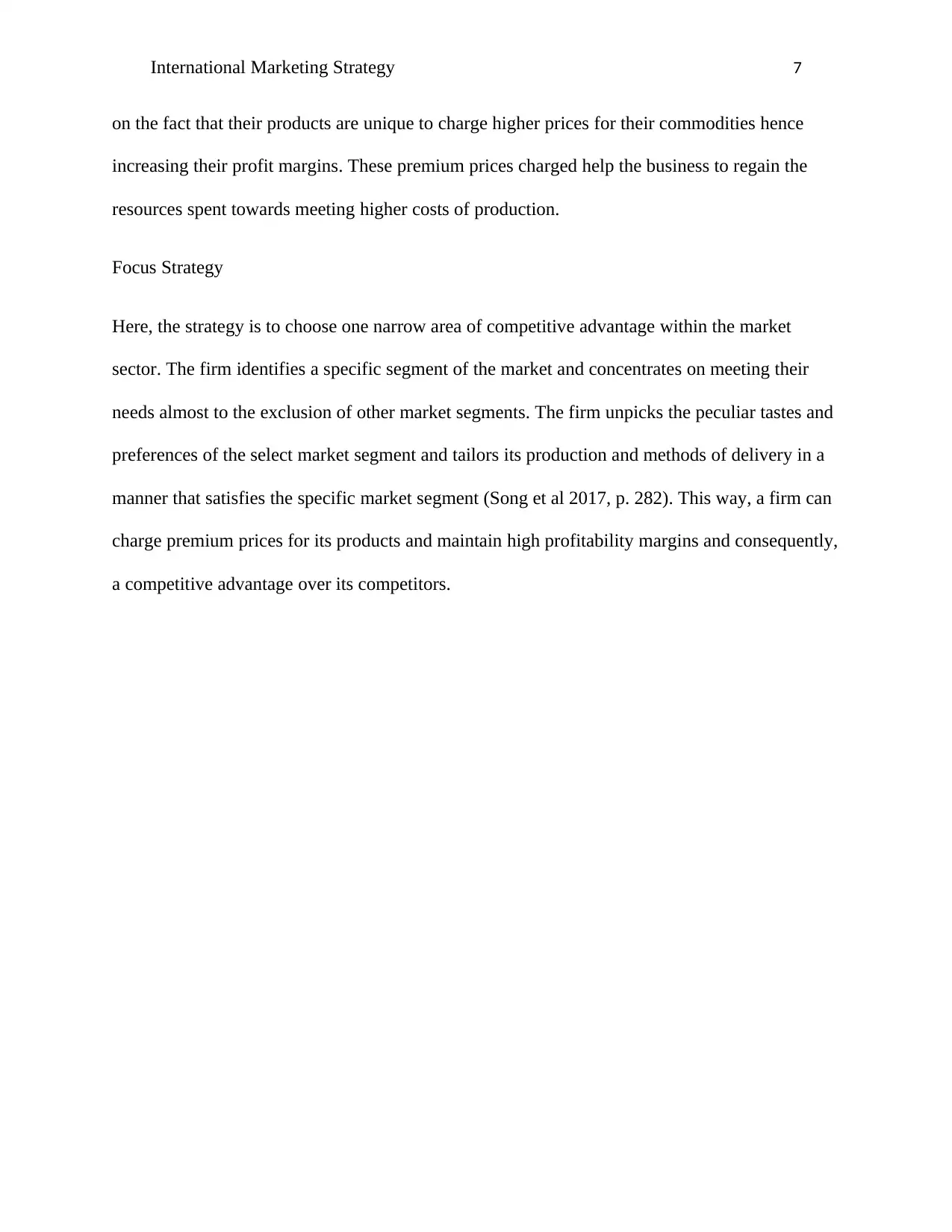
International Marketing Strategy 7
on the fact that their products are unique to charge higher prices for their commodities hence
increasing their profit margins. These premium prices charged help the business to regain the
resources spent towards meeting higher costs of production.
Focus Strategy
Here, the strategy is to choose one narrow area of competitive advantage within the market
sector. The firm identifies a specific segment of the market and concentrates on meeting their
needs almost to the exclusion of other market segments. The firm unpicks the peculiar tastes and
preferences of the select market segment and tailors its production and methods of delivery in a
manner that satisfies the specific market segment (Song et al 2017, p. 282). This way, a firm can
charge premium prices for its products and maintain high profitability margins and consequently,
a competitive advantage over its competitors.
on the fact that their products are unique to charge higher prices for their commodities hence
increasing their profit margins. These premium prices charged help the business to regain the
resources spent towards meeting higher costs of production.
Focus Strategy
Here, the strategy is to choose one narrow area of competitive advantage within the market
sector. The firm identifies a specific segment of the market and concentrates on meeting their
needs almost to the exclusion of other market segments. The firm unpicks the peculiar tastes and
preferences of the select market segment and tailors its production and methods of delivery in a
manner that satisfies the specific market segment (Song et al 2017, p. 282). This way, a firm can
charge premium prices for its products and maintain high profitability margins and consequently,
a competitive advantage over its competitors.
Paraphrase This Document
Need a fresh take? Get an instant paraphrase of this document with our AI Paraphraser
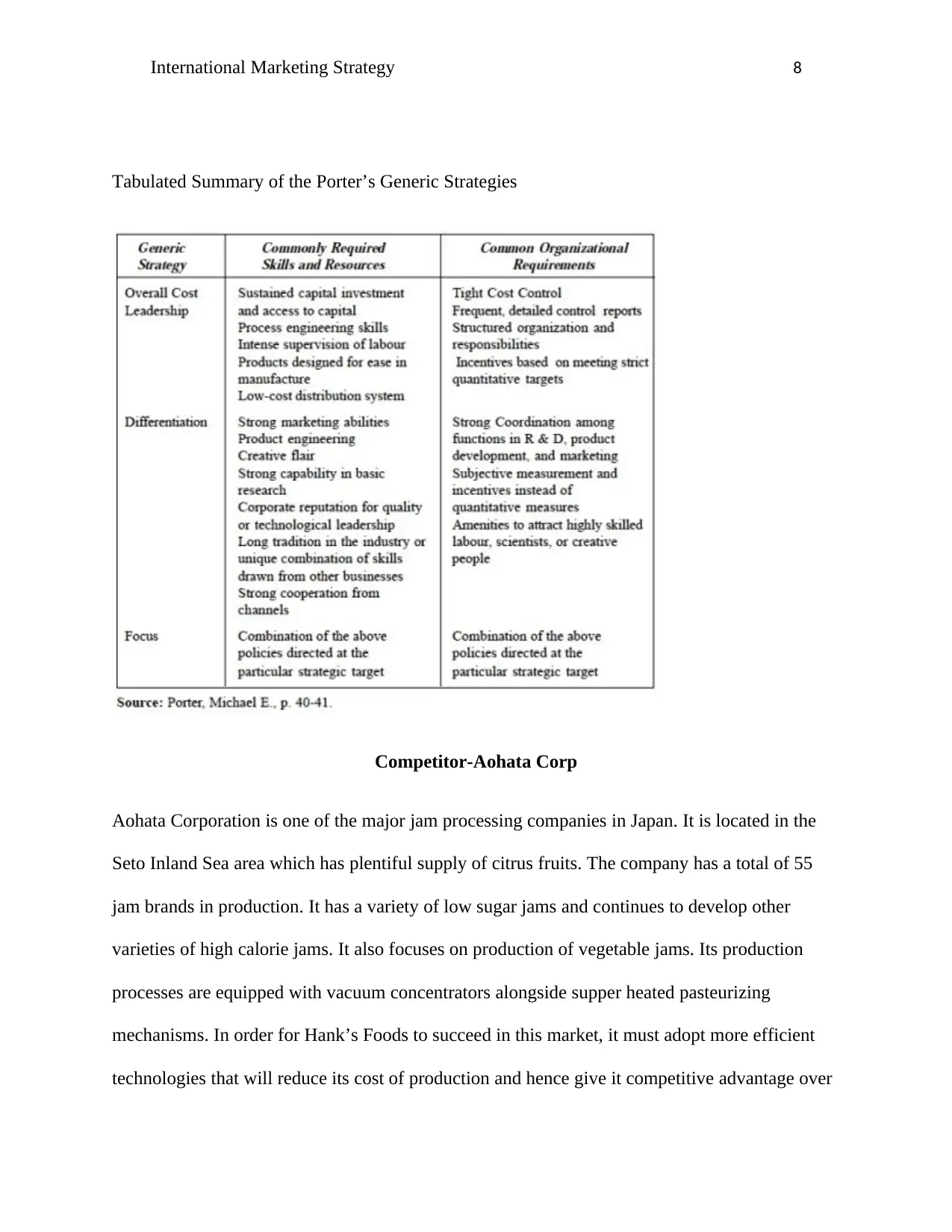
International Marketing Strategy 8
Tabulated Summary of the Porter’s Generic Strategies
Competitor-Aohata Corp
Aohata Corporation is one of the major jam processing companies in Japan. It is located in the
Seto Inland Sea area which has plentiful supply of citrus fruits. The company has a total of 55
jam brands in production. It has a variety of low sugar jams and continues to develop other
varieties of high calorie jams. It also focuses on production of vegetable jams. Its production
processes are equipped with vacuum concentrators alongside supper heated pasteurizing
mechanisms. In order for Hank’s Foods to succeed in this market, it must adopt more efficient
technologies that will reduce its cost of production and hence give it competitive advantage over
Tabulated Summary of the Porter’s Generic Strategies
Competitor-Aohata Corp
Aohata Corporation is one of the major jam processing companies in Japan. It is located in the
Seto Inland Sea area which has plentiful supply of citrus fruits. The company has a total of 55
jam brands in production. It has a variety of low sugar jams and continues to develop other
varieties of high calorie jams. It also focuses on production of vegetable jams. Its production
processes are equipped with vacuum concentrators alongside supper heated pasteurizing
mechanisms. In order for Hank’s Foods to succeed in this market, it must adopt more efficient
technologies that will reduce its cost of production and hence give it competitive advantage over
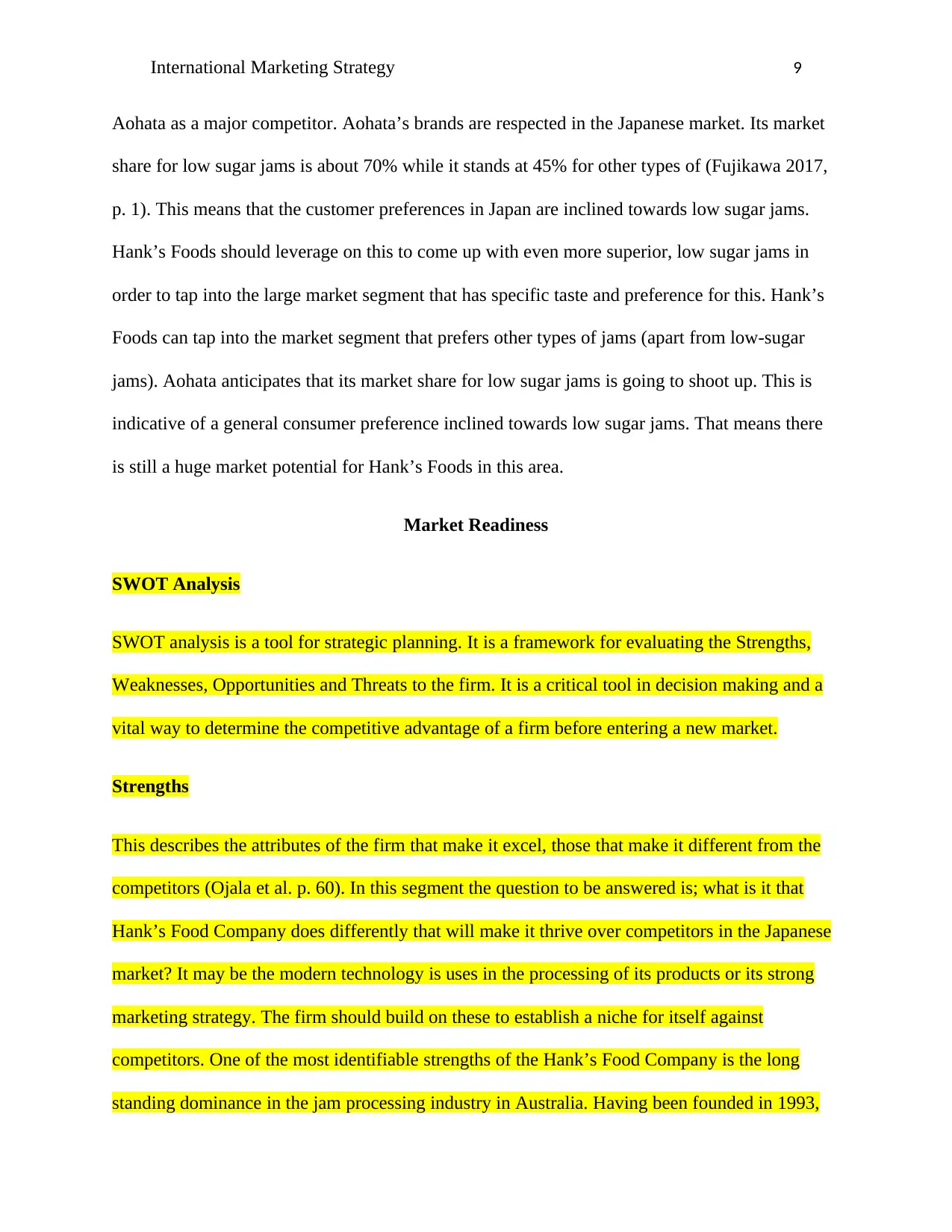
International Marketing Strategy 9
Aohata as a major competitor. Aohata’s brands are respected in the Japanese market. Its market
share for low sugar jams is about 70% while it stands at 45% for other types of (Fujikawa 2017,
p. 1). This means that the customer preferences in Japan are inclined towards low sugar jams.
Hank’s Foods should leverage on this to come up with even more superior, low sugar jams in
order to tap into the large market segment that has specific taste and preference for this. Hank’s
Foods can tap into the market segment that prefers other types of jams (apart from low-sugar
jams). Aohata anticipates that its market share for low sugar jams is going to shoot up. This is
indicative of a general consumer preference inclined towards low sugar jams. That means there
is still a huge market potential for Hank’s Foods in this area.
Market Readiness
SWOT Analysis
SWOT analysis is a tool for strategic planning. It is a framework for evaluating the Strengths,
Weaknesses, Opportunities and Threats to the firm. It is a critical tool in decision making and a
vital way to determine the competitive advantage of a firm before entering a new market.
Strengths
This describes the attributes of the firm that make it excel, those that make it different from the
competitors (Ojala et al. p. 60). In this segment the question to be answered is; what is it that
Hank’s Food Company does differently that will make it thrive over competitors in the Japanese
market? It may be the modern technology is uses in the processing of its products or its strong
marketing strategy. The firm should build on these to establish a niche for itself against
competitors. One of the most identifiable strengths of the Hank’s Food Company is the long
standing dominance in the jam processing industry in Australia. Having been founded in 1993,
Aohata as a major competitor. Aohata’s brands are respected in the Japanese market. Its market
share for low sugar jams is about 70% while it stands at 45% for other types of (Fujikawa 2017,
p. 1). This means that the customer preferences in Japan are inclined towards low sugar jams.
Hank’s Foods should leverage on this to come up with even more superior, low sugar jams in
order to tap into the large market segment that has specific taste and preference for this. Hank’s
Foods can tap into the market segment that prefers other types of jams (apart from low-sugar
jams). Aohata anticipates that its market share for low sugar jams is going to shoot up. This is
indicative of a general consumer preference inclined towards low sugar jams. That means there
is still a huge market potential for Hank’s Foods in this area.
Market Readiness
SWOT Analysis
SWOT analysis is a tool for strategic planning. It is a framework for evaluating the Strengths,
Weaknesses, Opportunities and Threats to the firm. It is a critical tool in decision making and a
vital way to determine the competitive advantage of a firm before entering a new market.
Strengths
This describes the attributes of the firm that make it excel, those that make it different from the
competitors (Ojala et al. p. 60). In this segment the question to be answered is; what is it that
Hank’s Food Company does differently that will make it thrive over competitors in the Japanese
market? It may be the modern technology is uses in the processing of its products or its strong
marketing strategy. The firm should build on these to establish a niche for itself against
competitors. One of the most identifiable strengths of the Hank’s Food Company is the long
standing dominance in the jam processing industry in Australia. Having been founded in 1993,
⊘ This is a preview!⊘
Do you want full access?
Subscribe today to unlock all pages.

Trusted by 1+ million students worldwide
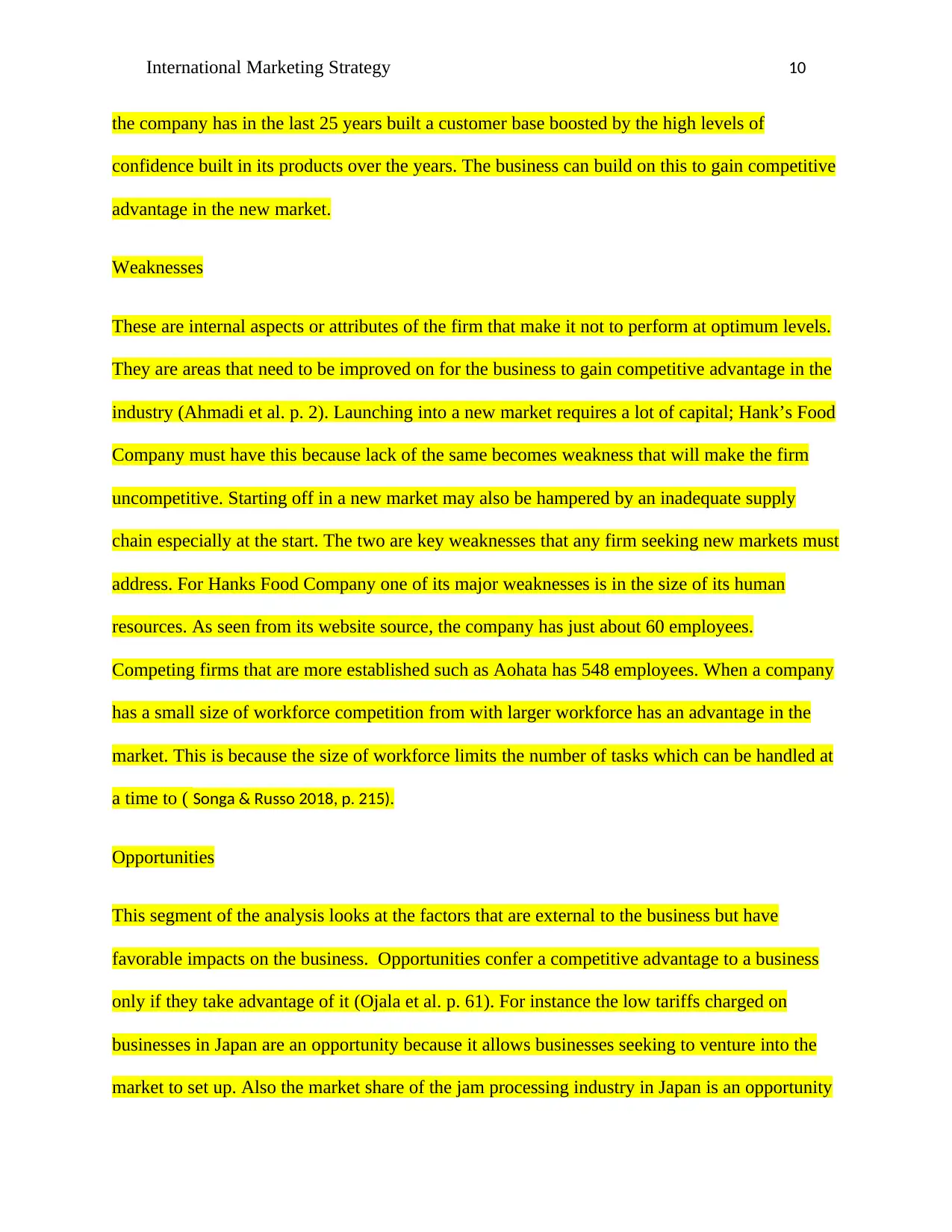
International Marketing Strategy 10
the company has in the last 25 years built a customer base boosted by the high levels of
confidence built in its products over the years. The business can build on this to gain competitive
advantage in the new market.
Weaknesses
These are internal aspects or attributes of the firm that make it not to perform at optimum levels.
They are areas that need to be improved on for the business to gain competitive advantage in the
industry (Ahmadi et al. p. 2). Launching into a new market requires a lot of capital; Hank’s Food
Company must have this because lack of the same becomes weakness that will make the firm
uncompetitive. Starting off in a new market may also be hampered by an inadequate supply
chain especially at the start. The two are key weaknesses that any firm seeking new markets must
address. For Hanks Food Company one of its major weaknesses is in the size of its human
resources. As seen from its website source, the company has just about 60 employees.
Competing firms that are more established such as Aohata has 548 employees. When a company
has a small size of workforce competition from with larger workforce has an advantage in the
market. This is because the size of workforce limits the number of tasks which can be handled at
a time to ( Songa & Russo 2018, p. 215).
Opportunities
This segment of the analysis looks at the factors that are external to the business but have
favorable impacts on the business. Opportunities confer a competitive advantage to a business
only if they take advantage of it (Ojala et al. p. 61). For instance the low tariffs charged on
businesses in Japan are an opportunity because it allows businesses seeking to venture into the
market to set up. Also the market share of the jam processing industry in Japan is an opportunity
the company has in the last 25 years built a customer base boosted by the high levels of
confidence built in its products over the years. The business can build on this to gain competitive
advantage in the new market.
Weaknesses
These are internal aspects or attributes of the firm that make it not to perform at optimum levels.
They are areas that need to be improved on for the business to gain competitive advantage in the
industry (Ahmadi et al. p. 2). Launching into a new market requires a lot of capital; Hank’s Food
Company must have this because lack of the same becomes weakness that will make the firm
uncompetitive. Starting off in a new market may also be hampered by an inadequate supply
chain especially at the start. The two are key weaknesses that any firm seeking new markets must
address. For Hanks Food Company one of its major weaknesses is in the size of its human
resources. As seen from its website source, the company has just about 60 employees.
Competing firms that are more established such as Aohata has 548 employees. When a company
has a small size of workforce competition from with larger workforce has an advantage in the
market. This is because the size of workforce limits the number of tasks which can be handled at
a time to ( Songa & Russo 2018, p. 215).
Opportunities
This segment of the analysis looks at the factors that are external to the business but have
favorable impacts on the business. Opportunities confer a competitive advantage to a business
only if they take advantage of it (Ojala et al. p. 61). For instance the low tariffs charged on
businesses in Japan are an opportunity because it allows businesses seeking to venture into the
market to set up. Also the market share of the jam processing industry in Japan is an opportunity
Paraphrase This Document
Need a fresh take? Get an instant paraphrase of this document with our AI Paraphraser
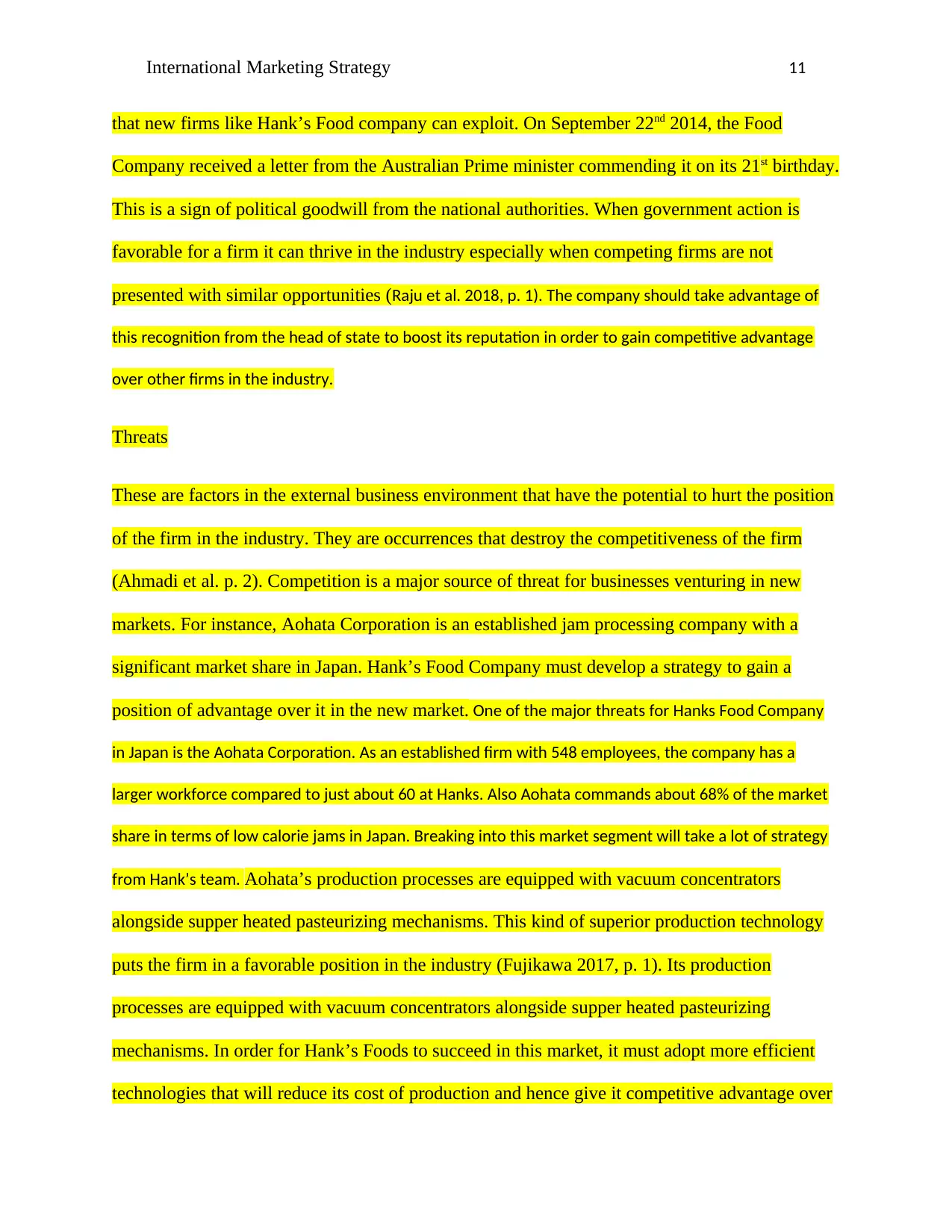
International Marketing Strategy 11
that new firms like Hank’s Food company can exploit. On September 22nd 2014, the Food
Company received a letter from the Australian Prime minister commending it on its 21st birthday.
This is a sign of political goodwill from the national authorities. When government action is
favorable for a firm it can thrive in the industry especially when competing firms are not
presented with similar opportunities (Raju et al. 2018, p. 1). The company should take advantage of
this recognition from the head of state to boost its reputation in order to gain competitive advantage
over other firms in the industry.
Threats
These are factors in the external business environment that have the potential to hurt the position
of the firm in the industry. They are occurrences that destroy the competitiveness of the firm
(Ahmadi et al. p. 2). Competition is a major source of threat for businesses venturing in new
markets. For instance, Aohata Corporation is an established jam processing company with a
significant market share in Japan. Hank’s Food Company must develop a strategy to gain a
position of advantage over it in the new market. One of the major threats for Hanks Food Company
in Japan is the Aohata Corporation. As an established firm with 548 employees, the company has a
larger workforce compared to just about 60 at Hanks. Also Aohata commands about 68% of the market
share in terms of low calorie jams in Japan. Breaking into this market segment will take a lot of strategy
from Hank’s team. Aohata’s production processes are equipped with vacuum concentrators
alongside supper heated pasteurizing mechanisms. This kind of superior production technology
puts the firm in a favorable position in the industry (Fujikawa 2017, p. 1). Its production
processes are equipped with vacuum concentrators alongside supper heated pasteurizing
mechanisms. In order for Hank’s Foods to succeed in this market, it must adopt more efficient
technologies that will reduce its cost of production and hence give it competitive advantage over
that new firms like Hank’s Food company can exploit. On September 22nd 2014, the Food
Company received a letter from the Australian Prime minister commending it on its 21st birthday.
This is a sign of political goodwill from the national authorities. When government action is
favorable for a firm it can thrive in the industry especially when competing firms are not
presented with similar opportunities (Raju et al. 2018, p. 1). The company should take advantage of
this recognition from the head of state to boost its reputation in order to gain competitive advantage
over other firms in the industry.
Threats
These are factors in the external business environment that have the potential to hurt the position
of the firm in the industry. They are occurrences that destroy the competitiveness of the firm
(Ahmadi et al. p. 2). Competition is a major source of threat for businesses venturing in new
markets. For instance, Aohata Corporation is an established jam processing company with a
significant market share in Japan. Hank’s Food Company must develop a strategy to gain a
position of advantage over it in the new market. One of the major threats for Hanks Food Company
in Japan is the Aohata Corporation. As an established firm with 548 employees, the company has a
larger workforce compared to just about 60 at Hanks. Also Aohata commands about 68% of the market
share in terms of low calorie jams in Japan. Breaking into this market segment will take a lot of strategy
from Hank’s team. Aohata’s production processes are equipped with vacuum concentrators
alongside supper heated pasteurizing mechanisms. This kind of superior production technology
puts the firm in a favorable position in the industry (Fujikawa 2017, p. 1). Its production
processes are equipped with vacuum concentrators alongside supper heated pasteurizing
mechanisms. In order for Hank’s Foods to succeed in this market, it must adopt more efficient
technologies that will reduce its cost of production and hence give it competitive advantage over
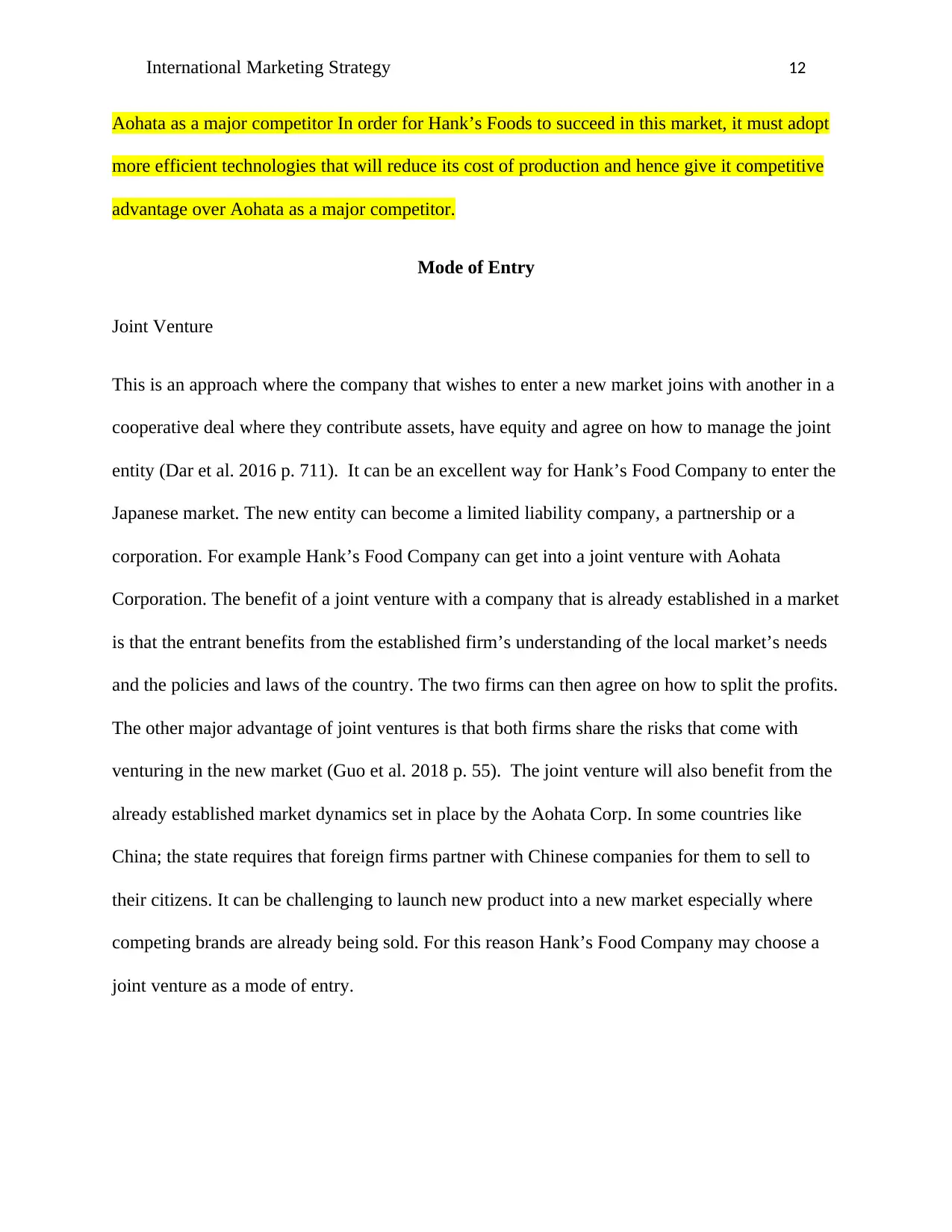
International Marketing Strategy 12
Aohata as a major competitor In order for Hank’s Foods to succeed in this market, it must adopt
more efficient technologies that will reduce its cost of production and hence give it competitive
advantage over Aohata as a major competitor.
Mode of Entry
Joint Venture
This is an approach where the company that wishes to enter a new market joins with another in a
cooperative deal where they contribute assets, have equity and agree on how to manage the joint
entity (Dar et al. 2016 p. 711). It can be an excellent way for Hank’s Food Company to enter the
Japanese market. The new entity can become a limited liability company, a partnership or a
corporation. For example Hank’s Food Company can get into a joint venture with Aohata
Corporation. The benefit of a joint venture with a company that is already established in a market
is that the entrant benefits from the established firm’s understanding of the local market’s needs
and the policies and laws of the country. The two firms can then agree on how to split the profits.
The other major advantage of joint ventures is that both firms share the risks that come with
venturing in the new market (Guo et al. 2018 p. 55). The joint venture will also benefit from the
already established market dynamics set in place by the Aohata Corp. In some countries like
China; the state requires that foreign firms partner with Chinese companies for them to sell to
their citizens. It can be challenging to launch new product into a new market especially where
competing brands are already being sold. For this reason Hank’s Food Company may choose a
joint venture as a mode of entry.
Aohata as a major competitor In order for Hank’s Foods to succeed in this market, it must adopt
more efficient technologies that will reduce its cost of production and hence give it competitive
advantage over Aohata as a major competitor.
Mode of Entry
Joint Venture
This is an approach where the company that wishes to enter a new market joins with another in a
cooperative deal where they contribute assets, have equity and agree on how to manage the joint
entity (Dar et al. 2016 p. 711). It can be an excellent way for Hank’s Food Company to enter the
Japanese market. The new entity can become a limited liability company, a partnership or a
corporation. For example Hank’s Food Company can get into a joint venture with Aohata
Corporation. The benefit of a joint venture with a company that is already established in a market
is that the entrant benefits from the established firm’s understanding of the local market’s needs
and the policies and laws of the country. The two firms can then agree on how to split the profits.
The other major advantage of joint ventures is that both firms share the risks that come with
venturing in the new market (Guo et al. 2018 p. 55). The joint venture will also benefit from the
already established market dynamics set in place by the Aohata Corp. In some countries like
China; the state requires that foreign firms partner with Chinese companies for them to sell to
their citizens. It can be challenging to launch new product into a new market especially where
competing brands are already being sold. For this reason Hank’s Food Company may choose a
joint venture as a mode of entry.
⊘ This is a preview!⊘
Do you want full access?
Subscribe today to unlock all pages.

Trusted by 1+ million students worldwide
1 out of 28
Related Documents
Your All-in-One AI-Powered Toolkit for Academic Success.
+13062052269
info@desklib.com
Available 24*7 on WhatsApp / Email
![[object Object]](/_next/static/media/star-bottom.7253800d.svg)
Unlock your academic potential
Copyright © 2020–2025 A2Z Services. All Rights Reserved. Developed and managed by ZUCOL.





